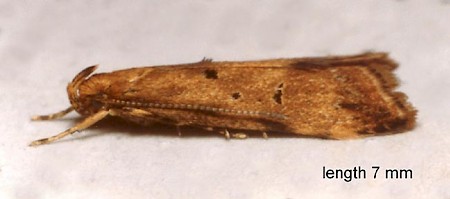35.028 BF866
Brachmia blandella
(Fabricius, 1798)
Wingspan 11 mm.
Widespread in Britain as far north as Yorkshire, this species occupies habitats where its foodplant, gorse (Ulex europaeus) occurs.
The species overwinters as a small larva in a slight spinning on gorse, and is full fed by early June, or earlier, when it pupates.
Adults are on the wing in July and early August, when they can be disturbed from large old gorse bushes in the early evening (Heckford & Sterling, 2004).
- Larva: (description Ian F. Smith):
Final instar larva
Foodplant: Ulex europaeus. Full fed final instar in early June, or earlier. Observations in captivity (Heckford & Sterling, 2004) suggest that the overwintering young larvae may feed on algae growing on the dead parts of U. europaeus.
Length: Final instar, 7mm, described.
Head: Pitchy brown, frons lighter.
Prothoracic shield: Pitchy brown, divided by a very fine light medial line.
Thoracic legs: Pitchy brown with whitish joints.
Body: Light brown with a slight pinkish tint on thorax. Slightly translucent, showing viscera as a darker brown dorsal line.
Spiracles: Unobtrusive. Peritreme slightly paler than integument.
Pinacula: Grey with a blackish setal spot. Surrounded by corona of integument slightly paler than rest of body.
Setae: Fine transparent and colourless, apart from slight brownish tint at base.
Anal segment (A10): Dark brown anal comb of four prongs. ( Apparent in photograph, but not noticed during examination of live larva.)
Anal plate: Anterior 60% shiny brown, darkest anteriorally. Posterior 40% translucent, coloured as body.
Prolegs: Coloured as body. Crochets dark brown.
Comment: The account of rearing this species in Heckford & Sterling, 2004, suggests that young larvae may not survive if removed from their spinnings on
U. europaeus. Consequently, it may be best to delay beating large old gorse bushes for this species until late May or early June, when the larva is nearly ready to pupate.

 UKMoths
UKMoths 





